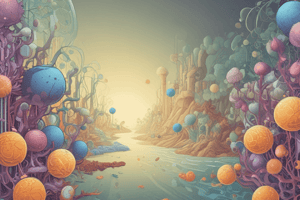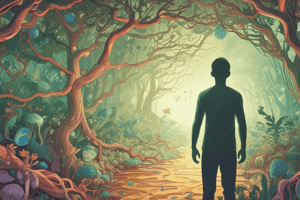Podcast
Questions and Answers
Where have bacteria been found living?
Where have bacteria been found living?
- Boiling mudpots
- Icy waters
- Lakes of caustic soda
- Pools of concentrated sulphuric acid
- All of the above (correct)
Bacteria have not been found in space.
Bacteria have not been found in space.
False (B)
Flashcards are hidden until you start studying
Study Notes
Microorganisms: Friend and Foe
Microorganisms and Their Characteristics
- Microorganisms, or microbes, are tiny living organisms that cannot be seen with the naked eye.
- They are classified into four major groups: bacteria, fungi, protozoa, and some algae.
- Viruses are also microscopic, but they are different from other microorganisms and can only reproduce inside the cells of a host organism.
Habitat and Distribution of Microorganisms
- Microorganisms can be found in all types of environments, including ice cold climates, hot springs, deserts, and marshy lands.
- They are also found inside the bodies of animals, including humans, and can be beneficial or harmful.
Beneficial Microorganisms
- Microorganisms are used in various industries, such as:
- Preparation of curd, bread, and cake
- Production of alcohol, wine, and acetic acid (vinegar)
- Cleaning up the environment by breaking down organic waste
- Increasing soil fertility through nitrogen fixation
- Microorganisms are used to produce medicines, such as antibiotics, which kill or stop the growth of disease-causing microorganisms.
- Vaccines are made from microorganisms to protect against diseases.
Harmful Microorganisms
- Disease-causing microorganisms, or pathogens, can cause diseases in humans, plants, and animals.
- They can spread through air, water, food, or physical contact with an infected person or animal.
- Examples of diseases caused by microorganisms include:
- Cholera, tuberculosis, and common cold in humans
- Malaria, caused by a protozoan parasite transmitted through the bite of a female Anopheles mosquito
- Dengue, caused by a virus transmitted through the bite of a female Aedes mosquito
Control and Prevention of Microbial Diseases
- Communicable diseases can be prevented by:
- Keeping a distance from infected persons
- Covering the nose and mouth while sneezing
- Washing hands regularly
- Maintaining personal hygiene and good sanitary habits
- Getting vaccinated against specific diseases
- Controlling the spread of malaria and dengue can be done by:
- Preventing water collection and mosquito breeding
- Using mosquito nets and repellents
- Spraying insecticides to control mosquito populations### Microorganisms: Friend and Foe
Disease Causing Microorganisms
- Microorganisms can cause diseases in humans, animals, and plants.
- Examples: anthrax disease caused by bacterium (Bacillus anthracis), citrus canker caused by bacteria, rust of wheat caused by fungi, and yellow vein mosaic of bhindi (Okra) caused by virus.
Food Poisoning
- Food poisoning can occur due to the consumption of food spoilt by microorganisms.
- Microorganisms that grow on food can produce toxic substances, making food poisonous.
- Examples: spoilage of food due to microorganisms, and food poisoning caused by consumption of spoilt food.
Food Preservation
- Methods of preserving food:
- Chemical method: using salts and edible oils to prevent the growth of microorganisms.
- Heat and cold treatments: boiling, refrigeration, and freezing to kill or inhibit microorganisms.
- Preservation by sugar: reducing moisture content to prevent bacterial growth.
- Preservation by oil and vinegar: creating an environment where bacteria cannot live.
- Common salt: used to preserve meat, fish, and fruits.
Nitrogen Fixation
- Nitrogen is an essential constituent of all living organisms.
- Nitrogen fixation: the process of converting atmospheric nitrogen into compounds that can be used by plants.
- Examples: Rhizobium bacterium that fixes nitrogen in leguminous plants, and blue-green algae that fix nitrogen directly from air.
Nitrogen Cycle
- The nitrogen cycle involves the conversion of nitrogen into various forms that can be used by plants and animals.
- Steps involved:
- Nitrogen fixation: conversion of atmospheric nitrogen into compounds.
- Nitrogen uptake: plants absorb nitrogen from the soil.
- Nitrogen release: plants and animals release nitrogen back into the soil.
- Denitrification: conversion of nitrogen back into atmospheric nitrogen.
Key Concepts
- Microorganisms: too small to be seen with the naked eye, but can be seen with a microscope.
- Types of microorganisms: bacteria, fungi, protozoa, algae, and viruses.
- Microorganisms can be found in air, water, and the bodies of plants and animals.
- Microorganisms can be useful for commercial production of medicines and alcohol, and for decomposition of organic waste.
- Microorganisms can also cause diseases and food poisoning.
Studying That Suits You
Use AI to generate personalized quizzes and flashcards to suit your learning preferences.




